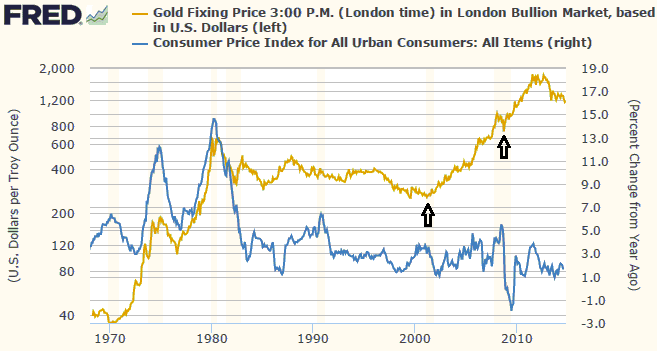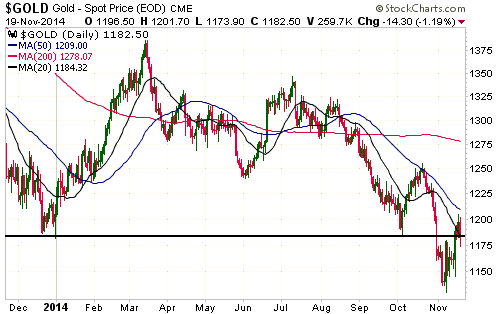![]() November 20, 2014
November 20, 2014
By Steve Saville http://Speculative-Investor.com
At the beginning of this year, banking behemoth Goldman Sachs (GS) called for gold to end the year at around $1050/oz. We didn’t agree with this forecast at the time and still believe it to be an unlikely outcome (although less unlikely than it was a few months ago), but earlier this year we gave Goldman Sachs credit for at least looking in the right direction for clues as to what would happen to the gold price. In this respect the GS analysis was/is vastly superior to the analysis coming from many gold-bullish commentators.
Here’s what we wrote when dealing with this topic back in April*:
“GS’s analysis is superior to that of many gold bulls because it is focused on a genuine fundamental driver. While many gold-bullish analysts kid themselves that they can measure changes in demand and predict prices by adding up trading volumes and comparing one volume (e.g. the amount of gold being imported by China) to another volume (e.g. the amount of gold being sold by the mining industry), the GS analysts are considering the likely future performance of the US economy.
The GS bearish argument goes like this: Real US economic growth will accelerate over the next few quarters, while interest rates rise and inflation expectations remain low. If this happens, gold’s bear market will continue.
The logic in the above paragraph is flawless. If real US economic growth actually does accelerate over the next few quarters then a bearish view on the US$ gold price will turn out to be correct, almost regardless of what happens elsewhere in the world. The reason the GS outlook is probably going to be wrong is that the premise is wrong. Specifically, the US economy is more likely to be moribund than strong over the next few quarters. It’s a good bet that inflation expectations will remain low throughout this year, but real yields offered by US Treasuries are more likely to decline than rise due to signs of economic weakness and an increase in the popularity of ‘safe havens’ as the stock market trends downward.“
We were right and GS was wrong about interest rates, in that both nominal and real US interest rates are lower today than they were in April. However, it is certainly fair to say that GS’s overall outlook as it pertains to the gold market has been closer to the mark than our own over the intervening period. This is primarily because economic confidence has risen, which is largely due to the continuing rise in the senior US stock indices.
So, regardless of whether or not gold ends up getting closer to GS’s $1050/oz target before year-end, we give GS credit for being mostly right for mostly the right reasons over the course of this year to date.
For their part, many gold bulls continue to look in the wrong direction for clues as to what the future holds in store. In particular, they continue to fixate on trading volumes, seemingly oblivious to the fact that for every net-buyer there is a net-seller and that the change in price is the only reliable indicator of whether the buyers or the sellers are the more motivated.
*The 16th April Interim Update
Gold versus the CPI
Like old soldiers, old beliefs never die. In the financial world, one of the many old beliefs that hangs on despite a pile of conflicting evidence is the one about gold being a hedge against, or a play on, so-called “CPI inflation”.
The belief that big moves in the gold price are primarily driven by “price inflation” as measured by the CPI was spawned by what happened during 1972-1982. As illustrated by the following chart, there was a strong positive correlation between the gold price and the 12-month rate of change in the CPI during this period. However, the chart also shows that the positive correlation of 1972-1982 did not persist over the subsequent 32 years. Furthermore, it shows that the most recent two multi-year rallies in the gold price (the rallies that began in early-2001 and late-2008) had nothing to do with “CPI inflation”. These rallies got underway in the midst of steep declines in the CPI’s growth rate and were at no time supported by a rapidly-rising CPI.
All substantial gold rallies are about falling confidence in the monetary authorities. The fall in confidence can be associated with so-called “price inflation”, but it certainly doesn’t have to be. As was the case with the substantial gold rallies that began in 2001 and 2008, it can be associated with stock market weakness, economic recession and minimal “price inflation”.
At some point within the next 10 years there will probably be a multi-year rally in the gold price that is linked to a large rise in the CPI, but, like the most recent two examples, we expect that the next multi-year gold rally will have very little to do with “CPI inflation”. Instead, we expect that it will be set in motion by either a major top in the US stock market or by the US stock market topping relative to other stock markets if not in nominal terms. That the S&P500’s upward trend has extended much further than we thought it would, in both nominal terms and relative to other important global equity indices, is the main reason we’ve been early (that is, wrong) on the gold market.
Why GLD’s bullion inventory follows the gold price
This is a topic we’ve dealt with several times in TSI commentaries over the years, and earlier this week we dealt with it at the TSI Blog. Here’s the link: http://tsi-blog.com/?p=1135
Current Market Situation
The US$ gold price put some distance between itself and support/resistance at $1180 (+/- $2) on Tuesday, but then dropped back to the major demarcation level on Wednesday. We suspect that this will prove to be a successful test of the preceding upside breakout. If so, there could be some additional minor weakness over the next 1-3 trading days, but gold should hold above $1170 on a daily closing basis.
Our expectation continues to be that gold will move up to $1210-$1240 within the next 2-3 weeks.
At this stage we think that gold has little chance of making a solid break above $1250 before year-end, but that it will do so during the first quarter of next year. As always, however, what gold does will be determined to a large extent by what happens in other financial markets, with the US stock market being the most influential at the moment. It will not be determined by changes in the volume of gold flowing into China or India.
